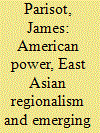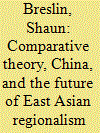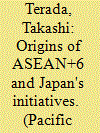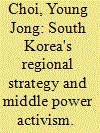|
|
|
Sort Order |
|
|
|
Items / Page
|
|
|
|
|
|
|
| Srl | Item |
| 1 |
ID:
122832


|
|
|
|
|
| Publication |
2013.
|
| Summary/Abstract |
Recent years have seen a revival of discussions on American decline. This paper intervenes in this debate by suggesting that there is a tendency towards partial conceptualisations of US power. It suggests a new historical materialist perspective that makes it possible to theorise American Empire as a relational social totality embedded within global capitalism. The paper then analyses the social limits of China's rise and the integration of East Asian regionalisation into American Empire, suggesting the extent to which world power has shifted east has tended to be overestimated. It also analyses the emergence of Brazil, India, and the brics meetings, suggesting these developments have a limited, but overstated, capacity to challenge American Empire.
|
|
|
|
|
|
|
|
|
|
|
|
|
|
|
|
| 2 |
ID:
152746


|
|
|
|
|
| Summary/Abstract |
How is the Association of Southeast Asian Nations performing as a manager of regional cooperative activities in East Asia? Despite increasing attention regarding its role in development of East Asian regionalism, few scholarly discussions about the effectiveness of ASEAN's managerial practices at the operational level have been attempted. This article aims to fill the scholarly gap based on the author's participatory observation of discussions among practitioners regarding management of cooperative activities for ASEAN mechanisms. It suggests that ASEAN's performance as a driver of East Asian cooperation has been insufficient and may possibly have weakened the mechanisms for greater cooperation.
|
|
|
|
|
|
|
|
|
|
|
|
|
|
|
|
| 3 |
ID:
174856


|
|
|
|
|
| Summary/Abstract |
After a decade of vibrant scholarly and political discourse regarding the prospects of East Asian integration, the narrative of regionalism has lost its luster in favor of a darker regional narrative. Has the idea of East Asian regionalism come to pass, and if so, what explains the decline in the narrative of Asian regionalism both as a policy idea and as a research program? After providing empirical evidence tracking the rise and decline in scholarly publications and news articles regarding Asian regionalism, I present several plausible reasons explaining this decline. Among them, the perceived shift in Chinese strategic behavior, and in turn, the adoption of more pragmatic interpretations of Asian security practices – one defined by power balancing and institutional rivalry rather than community building – appears to have struck a major blow to the East Asia regional project.
|
|
|
|
|
|
|
|
|
|
|
|
|
|
|
|
| 4 |
ID:
097921


|
|
|
|
|
| Publication |
2010.
|
| Summary/Abstract |
Despite the development of an increasingly sophisticated literature on comparative regional integration drawing from a variety of cases, the European experience remains the most often used benchmark against which other integrative processes are judged; there is still an often implicit expectation that 'successful' processes of regionalism will end up looking something like the European Union. While it is correct to move away from such a 'Euro-dominance', the theoretical lessons learned continue to have salience when applied to emerging and competing forms of integrative processes in East Asia. In particular, when economic considerations dominate regional relations - at times of economic crises - then integrative logics and strategies come to the fore. In more 'normal' times when geo-strategic considerations reassert themselves, then the consensus over region building and the very nature of the region itself is weakened and cooperation is replaced by competing visions and the over-supply of region.
|
|
|
|
|
|
|
|
|
|
|
|
|
|
|
|
| 5 |
ID:
108572


|
|
|
|
|
| Publication |
2011.
|
| Summary/Abstract |
Certain developments are emerging in East Asia that could accentuate the divisions
among ASEAN members over East Asian regionalism. One is the trend toward
financial and trade cooperation between ASEAN and Northeast Asian countries
that will make it difficult for ASEAN to resist East Asian regionalism. Another is
the growing global economic importance of East Asia that can reduce ASEAN's
centrality in this regionalism. These divisions are most pronounced between
Malaysia and Indonesia. While Malaysia wants the regional grouping to be a
community, Indonesia sees it as basically functional in purpose. Malaysia, unlike
Indonesia, sees some economic, especially financial, benefit from the regional
grouping. China is not seen by Malaysia as a threat to the region and can best be
accommodated in Malaysia's preferred grouping, the ASEAN Plus Three, while
Indonesia favors the East Asia Summit where India can help balance China.
|
|
|
|
|
|
|
|
|
|
|
|
|
|
|
|
| 6 |
ID:
109474


|
|
|
|
|
| Publication |
2011.
|
| Summary/Abstract |
Although economically interdependent, political rivalry between Japan and China have brought about the inability of the Association of Southeast Asian Nations Plus Three (APT) process to transform itself into an East Asia Summit (EAS) as originally envisioned. The existence of the APT and the EAS as two separate entities not only reflected the politico-security rivalry between the two neighbours but more importantly affected the direction and progress of East Asian regionalism as a whole. Aiming to provide a historical account of the EAS process and examine Japan's role in the development of the EAS framework, this paper argues that Japan has put greater attention on the EAS and made numerous unilateral initiatives to develop it. While Japan does not seek ultimate power, it considers the EAS as an excellent opportunity to: (i) raise its influence in the region vis-à-vis China; (ii) elevate the status of the EAS in region-building and (iii) check Chinese advances by fulfilling its long-held policy of having other Asia Pacific countries, primarily Australia and New Zealand, join. Nevertheless, the decision to expand the EAS to include the USA and Russia will have some adverse effects on Japan's unilateral ambitions and the furtherance of regionalisation processes.
|
|
|
|
|
|
|
|
|
|
|
|
|
|
|
|
| 7 |
ID:
094446


|
|
|
|
|
| Publication |
2010.
|
| Summary/Abstract |
The move towards ASEAN+6 began in earnest with a speech by Junichiro Koizumi in 2002, when the former prime minister called for Australia and New Zealand to be included as 'core members' in the process towards creating a community in East Asia, along with the 10 members of ASEAN and China, Korea and Japan. With the inauguration of the East Asian Summit in 2005, a tangle of regional institutions competes for attention and resources, and as long as the 16-nation ASEAN+6 framework continues to coexist with the 13-nation ASEAN+3 framework in East Asia, the argument as to which is the more effective framework for regional cooperation continues to linger. Why is Japan so interested in promoting ASEAN+6 as an 'expanded' East Asian regional concept, despite the existence of ASEAN+3?
This article has considered how changes in the US-led structure have influenced Japan as the agent in which regional integration within the ASEAN+6 framework was generated, by focusing on the process by which consideration of a countermeasure to the rise of China led Japan's Ministries - such as Ministry of Foreign Affairs and Ministry of Economy, Trade and Industry - to propose and advocate the East Asian Summit and the Comprehensive Economic Partnership in East Asia, respectively, in lines with prime ministers' policy stances. The regional structure in which China's challenging behaviour was more directly relevant, can be considered to have exerted a strong influence on the Japanese state as an agent where two rival ministries shared the concern and commonly promoted ASEAN+6 framework despite the lack of strong inter-ministerial communication. This article finally examines the more recent changes in the structure, highlighted by the US initiative in the promotion of the Free Trade Area of the Asia-Pacific and the re-emergence of ASEAN+3 triggered by China's aggressive regional financial initiatives, and asserts these events have dimmed the prospects for ASEAN+6, since these changes meant the transformation of the preconditions behind the birth of ASEAN+6 in Japan.
|
|
|
|
|
|
|
|
|
|
|
|
|
|
|
|
| 8 |
ID:
092519


|
|
|
| 9 |
ID:
131579


|
|
|
|
|
| Publication |
2014.
|
| Summary/Abstract |
With a focus on challenges and prospects of APT in East Asian regionalism, among the challenges, the establishment of strong regional and financial institutions such as APT and CMI is not being welcome by the U.S. and the major international financial institutions like IMF, World Bank, etc, so they may lobby to undermine it. There are also calculations that APT would probably be dominated by China. Such calculations by Japan, Indonesia, Thailand, Vietnam, etc favorably affected the deeper regionalization process of APT, and at this framework, no one could balance with China in security and political terms. Such anxiety among its members is also another major obstacle in a deeper process of regionalization. On strategic fronts too, there are competitions among the members of APT.
|
|
|
|
|
|
|
|
|
|
|
|
|
|
|
|
| 10 |
ID:
140518


|
|
|
|
|
| Summary/Abstract |
Because of rapid economic growth and close economic interdependence, East Asia has recently been in the spotlight of regional integration theorists. Currently, East Asia is being remapped in two ways: one is the Regional Comprehensive Economic Partnership (RCEP); and the other is the Trans-Pacific Strategic Economic Partnership (TPP). This article aims at predicting the winner of inter-institutional balancing between the two tracks from a viewpoint of power politics. To do so, realist hypotheses are made of regional integration and they are tested against the Integration Achievement Score (IAS) data. As a result, newly suggested hypotheses and some conventional ideas are strongly supported. These findings hold, regardless of model specifications and measurement of variables. Next, after analyzing how much the RCEP and the TPP accord with those findings, probabilities are presented showing that the two tracks can achieve regional economic integration. In conclusion, the TPP is expected to become the winner of inter-institutional balancing.
|
|
|
|
|
|
|
|
|
|
|
|
|
|
|
|
|
|
|
|
|